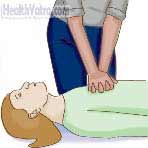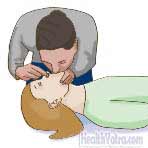تعريف
Cardiopulmonary resuscitation (CPR) is a series of steps to help a person who is not responding and has stopped breathing. CPR helps deliver oxygen rich blood to the body tissue when the body is not able to do this on its own.
أسباب هذا الإجراء
CPR is given to a child who is not breathing. Reasons for this may include:
- صدمة
- Sudden cardiac arrest
- Cerebrovascular accident (bleeding in the brain)
- الحروق
- الاختناق
- الغرق
- Electrical shocks and lightning strikes
- عدوى شديدة
- Drug overdose
- نزيف شديد
- انخفاض حرارة الجسم
The outcome will depend on the cause and how soon effective CPR was initiated. Many people are unable to regain a normal heartbeat after it has stopped.
المضاعفات المحتملة
It is possible that ribs may fracture or break during chest compressions. Other complications, like a puncture of a lung, are also possible.
People with weakened bones have a higher risk of fractures from CPR. However, there is greater risk of death if CPR is delayed or not done correctly.
What to Do
قبل الإجراء
When you see a child suddenly collapse or find a child unconscious on the ground, immediately check to see if he is responsive. Tap the child and ask: “Are you OK?” If the child is unresponsive, follow these steps:
- If someone is with you, have that person call for medical help right away. That person should also get the automatic external defibrillator (AED). An AED is a device that delivers electric shocks to the person’s heart. If you are alone, do CPR for about two minutes before calling for medical help and getting the AED.

- If the person is not breathing or only gasping, begin CPR by doing chest compressions:
- Place the palm of your hand on the lower half of the chest directly over the sternum. One or two hands may be used.
- Straighten your arms and lock your elbows. Begin pressing down in a straight motion. The compressions should be at least two inches deep.
- Push hard and fast at a rate of 100 compressions per minute.
- Allow the chest to rise completely between compressions.

- Minimize interruption between compressions.
-
- If you are trained in CPR, give two rescue breaths after 30 compressions. To give rescue breaths:
- Open the airway by placing one hand on the forehead and lifting the chin with your other hand.
- Gently tilt the head backward. Pinch the victim’s nose and cover his mouth with yours.
- Breathe twice into his mouth until you see the chest rise. Breaths should be about one second each.
- After giving two rescue breaths, do 30 compressions. Continue the cycle of two breaths and 30 compressions.
- If you are not trained in CPR, continue doing the chest compressions without giving rescue breaths.
- If another person is present, take turns doing the chest compressions to avoid getting tired. If two people are giving CPR, the ratio of chest compressions to breaths is 15 compressions and two breaths.
- Give CPR until the AED is brought to the scene or until:
- Medical help arrives
- It becomes unsafe to continue
- The victim regains consciousness and is able to breathe
- To use the AED:
- Turn the AED on.
- Attach the pads.
- Follow the prompts. If advised, deliver the shock. If the shock is not advised, the AED will tell you to resume CPR.
كم من الوقت سيستغرق ؟
The length of time for CPR depends on the underlying causes and response time of medical help.
Will It Hurt the Child?
The patient is unconscious when CPR is given. The procedure does not hurt. Some children may complain of soreness in the chest after regaining consciousness.
رعاية ما بعد العملية
The emergency team will take over care when they arrive.
Children will need to be taken to the hospital for evaluation following CPR.
Call For Help
If a child is unresponsive and someone is with you, have that person call for medical help right away. If you are alone, do CPR for about two minutes before calling for medical help.
- If you are trained in CPR, give two rescue breaths after 30 compressions. To give rescue breaths:
